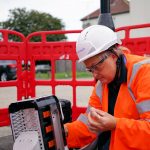Vodafone and MediaTek Test Pushes 5G Upload Speeds up to 277Mbps

Mobile network operator Vodafone recently hooked up with semiconductor (CPU etc.) firm MediaTek to test the combination of their 5G Standalone (5G SA) based mobile broadband network with the latest M90 modem. The solution proved able to deliver 5G uplink speeds of up to 277Mbps at their test facility in Madrid (Spain).
The majority of 5G mobile networks today are still Non-Standalone (NSA), which means they are partly reliant upon older and slower 4G infrastructure. But SA networks are pure end-to-end 5G that can deliver ultra-low latency times, greater energy efficiency, better speeds (particularly uploads), network slicing, improved support for Internet of Things (IoT) devices, Voice over New Radio (VoNR or Vo5G) and increased reliability and security etc.
Vodafone is deploying their new 5G SA network across a number of countries in Europe, including the United Kingdom, but to make the most of this requires network hardware and end-user devices able to access the full potential. This is where the new modem from MediaTek could help, although they’re not the only such chipset in town.
Advertisement
While approximately 90% of mobile traffic traditionally utilises the downlink channel from mobile masts to users’ smartphones, there is still a growing need for good upload speeds too (e.g. remote play, cloud services / gaming, businesses etc.). On this front, the new MediaTek processor theoretically claims it can deliver download speeds of up to 12Gbps (Gigabits per second) and boosts uplink performance by up to 20% based on the latest 5G specification (Release 17 – developed by 3GPP).
The test itself also boosted the 5G uplink connection by using carrier aggregation to combine several spectrum channels (bands), which increased the capacity and speed of the connection up to 277Mbps. But some key details remain unclear, such as exactly what bands were used, over what distance and how much spectrum frequency this involved etc.
Vodafone and MediaTek also used MIMO (multiple input, multiple output) antennas to transmit two data streams simultaneously from a single smartphone to the nearest mast, as well as tested it with the two key mobile data transmission methods – Frequency Division Duplex (FDD) and Time Division Duplex (TDD). “This is like adding extra 5G lanes to an existing mast. TDD is used to provide capacity at high frequency bands and is used in urban areas, and FDD is used on lower frequency bands to provide wider coverage,” said Vodafone.
HC Hwang, General Manager of Wireless Comms System at MediaTek, said:
“Enhancing uplink performance using groundbreaking technology will ensure next generation 5G experiences continue to support users globally.”
However, one key caveat here is that commercial smartphones do not yet support this feature (as they need uplink MIMO in FDD), but Vodafone and MediaTek said they aim to drive the development of compatible devices for the benefit of smartphone users everywhere.
Advertisement
Mark is a professional technology writer, IT consultant and computer engineer from Dorset (England), he also founded ISPreview in 1999 and enjoys analysing the latest telecoms and broadband developments. Find me on X (Twitter), Mastodon, Facebook, BlueSky, Threads.net and Linkedin.
« NGMN Push Mobile Operators to Adopt More Effective Carbon Emissions Reports
Virgin Media O2 Business Launches Teams Phone Mobile »























































Maybe it would be a good idea for Vodafone to sort out what they already have, no good having higher speed if you can’t get any signal, one of the reasons I dropped Vodafone all those years ago and their customer service or lack of it.
From what I have heard, nothing have changed.
The only valuable part is “at their test facility in Madrid”. You’ll never see this because of number of other problems they should resolve in the first place.
Depends where you are, for me streaming has never been a problem on Vodafone (been quite impressed with it, using Vodafone unlimited max)
I probably switch my main ee contract over if it was due to the fact my pocket landline is stuck on it (need to work out how to port it to a voip provider so I am not paying £10 a month for it) that said I find ee generally good
Then why across the EU and Asia, 5G can reach beyond 1 gig speeds there but exceptionally rarely in the UK…..
“ The test itself also boosted the 5G uplink connection by using carrier aggregation to combine several spectrum channels (bands), which increased the capacity and speed of the connection up to 277Mbps. But some key details remain unclear, such as exactly what bands were used, over what distance and how much spectrum frequency this involved etc.”
-Quite, these are some pretty critical details left out of the announcement. How can Vodafone out something like this out without the context. It does sound like to achieve anywhere near this sort of result in the real world, they would need densify the network by an order of magnitude, with a huge increase in masts and small cells everywhere, as you wont be able to serve lots of users like this who are all using the same cell site (even if they were all standing right next to it!)
Why dont these companies just focus on being a really good efficient utility company and serve their customers well by providing them ubiquitous reliable connectivity everywhere they need it, instead of trying to deliver ever faster speeds which the majority of outdoor users & use cases will never require.
Wow a whopping 277mbs crazy! If today was 2016